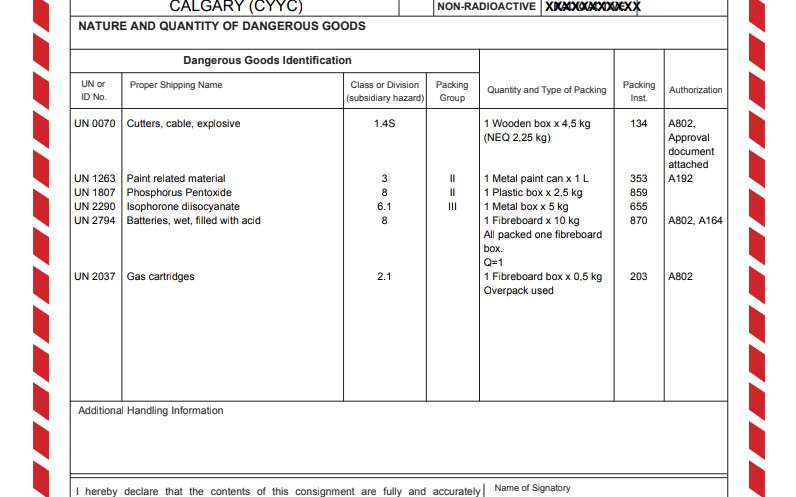I get questions from around the world! Like this one on February 16, 2021:
Hello,
Let me introduce myself,
I am <<Name>> from Belgium. I’m trying to understand the DGR to help a friend who is about to take her IATA category 6 exam. I have no experience in the transportation of dangerous goods.
I found your site by chance while doing a search on the Q Value. Your explanation is interesting. Read: Calculating the “Q” Value for Different Dangerous Goods in a Single Outer Packaging (All Packed in One)
On the other hand, I have a question: in practice, where to indicate on a DGD, that we have an official state authorization to proceed with the air transport of a certain dangerous good. In my example, I am talking about the State variation BEG-02 of Belgium (regarding Class 1) which is also included in the DGR (8.1.6.9.4 Fourth Sequence – Authorizations). Is it in the Authorization column or in the Additional handling information box ?
Because there is no example on the DGR and I did not find any example on the Internet. Enclosed, you’ll find my fillable DGD for my question.
And in general, when the same Special provision applies to different dangerous goods in the same shipment, do I have to write the same number of the Special provision for each UN number ? For example A802. Do I have to write it as many times as it applies to different dangerous goods.
Thank you for taking the time to answer my question. And I apologize for my low level of English. I am French-speaking.
My answer that day:
Note: This answer is derived from the 62nd Edition of the IATA Dangerous Goods Regulation, effective for calendar year 2021 only.
I will try to answer your questions below.
- 8.1.6.9.4 requires only one of the following 16 Special Provision codes to be displayed in 4th Sequence Authorization of the Shipper’s Declaration for Dangerous Goods if applicable to that consignment: A1, A2, A4, A5, A51, A81, A88, A99, A130, A190, A191, A201, A202, A211, A212, & A331.
- Other Special Provision codes may be included in 4th Sequence Authorization but are not required to be displayed.
- Per 8.1.6.9.4(b), if a consignment is being shipped under any governmental authorization a statement that the approval is attached to the Declaration must be included in 4th Sequence Authorization. The authorization(s) must include:
- quantity limitations;
- packaging requirements;
- aircraft type, if applicable;
- any other relevant information.
- BEG-02 requires a governmental authorization. Therefore, a copy of the approval should include the required information and be attached to the Declaration. A reference to it must be included in 4th Sequence Authorizations of the Shipper’s Declaration for Dangerous Goods. Note: BEG-02 is one of many State variations and operator variations that effect 8.1.6.9.4.
- Your last question about how many times to write the Special Provision code is more difficult to answer. There is no clear indication in the IATA DGR. However, my reading of the DGR beginning at 8.1.6.9 tells me that the description is for the entire consignment, not each individual dangerous good. Therefore, the display of the Special Provision Code or other information in 4th Sequence Authorizations would be just once to represent the entire consignment. (This may warrant further research).
I hope this helps. Please contact me with any other questions.
Contact me the next time your USDOT, IATA (air), or IMO (vessel) training is due to expire. |
That seemed to do it:
Thank you, Sir, for taking the time to answer my questions.
I understand now.
I will get back to you later if I have any questions.
Regards,
Conclusion:
The IATA Dangerous Goods Regulations – like the Dangerous Goods Code of the International Maritime Organization – are truly international. States, e.g., Belgium, Mexico, China, &etc., and air carriers (operators) have variations to the regulations, but otherwise, the regulations for the international transport of dangerous goods by air are the same in Belgium as they are in the U.S. Learn more about IATA Dangerous Goods Training.

